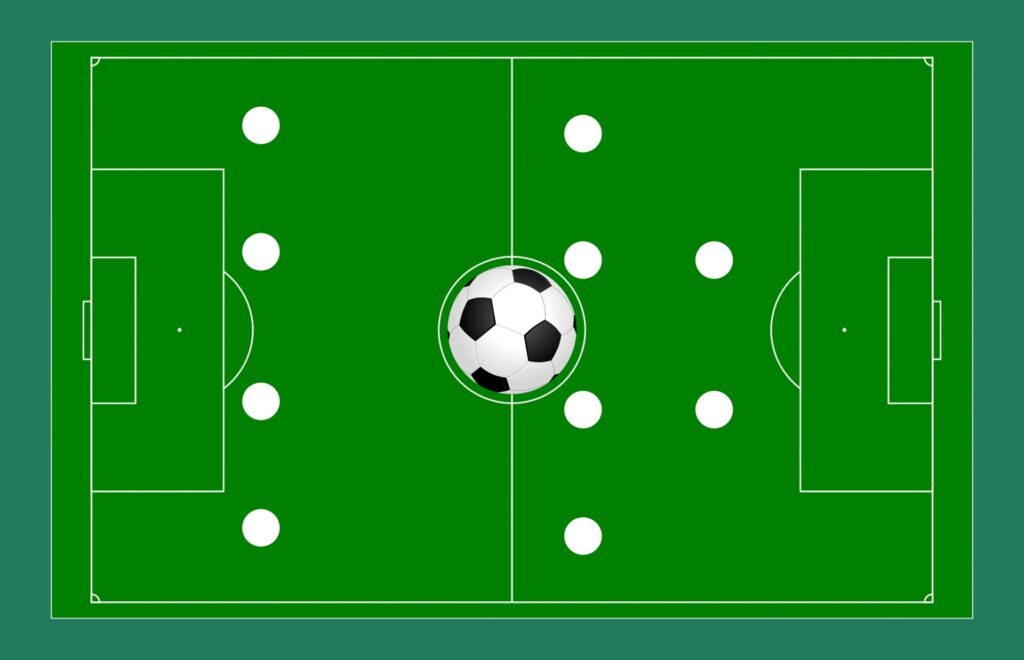Photo: publicdomainpictures.net
As a key part of the sporting culture for many nations, football and the way in which it is played, can be a societal reference point both domestically and internationally.
From the attritional, full-blooded approach of the English, the pragmatism of the Italians, the flair of the Brazilians and the efficiency of the Germans – stereotypes are formed by the formation and way in which teams from a particular country play the game.
Evolution, investment and development in football has been exponential over the past few decades and this has had a seismic impact in the approach that managers take when selecting and training their teams.
The way in which a football team sets up is common knowledge amongst most of the football fraternity and punters and bookmakers will set their odds, dependent on the formations particular teams utilise.
Many UK football betting sites also offer dedicated markets and insights, analysing the formations particular teams adopt and there is a whole footballing sub-culture surrounding tactics and formations.
Yet for the players on the pitch and the managers on the sidelines, implementing an effective formation is key, whether it is part of their long-term planning or simply to win the next game in front of them.
Here is a breakdown of the way in which football formations have evolved over the years:
Attack, Attack, Attack!
Innovations in football have long been part of the game and back at the onset of 11 vs 11 matches, managers and players saw outscoring the opposition as the best way to go.
Adopting a 2-3-5 formation (two defenders, three midfielders and five attackers), was hugely popular at the end of the 1800’s and start of the 1900’s, as the game became more widely played across the world.
Moving away from being a public school sport and to a game played by working class individuals, a greater emphasis on scoring goals came to the fore.
A scan through the footballing archives attests to how high scoring many football matches were at this time and that trend continued until the start of the first World War.
W stands for Win
Back at the start of the 20th century, a few clubs – particularly in England – began to see the merit in setting up more defensively than those who played the game before them.
Herbert Chapman enjoyed great success as the manager of both Huddersfield Town and Arsenal, where he is widely credited with developing the W formation.
Sometimes referred to as the WM formation, the premise was for clubs to play with five defenders (three half-backs and two wing-backs), as well as five forwards.
This structure enabled sides to control both the tempo of the game and plenty of spaces on the pitch and very few teams were able to compete with Chapman’s innovations.
Continental Catenaccio
Following the Second World War, the impact of teams playing against each other in European competitions broadened the horizons of every team and different variations of the game were introduced.
One of the most obvious examples of this was the catenaccio, an Italian formation that focused on being able to soak up pressure and then catch sides on the counter attack.
The innocence of simply looking to win the game by outscoring the opposition was completely thrown out of the water by the catenaccio, which saw teams adopt a far more pragmatic way of playing.
Conserving energy and ensuring that key attacking players are ready to impact the game at key moments was a huge by-product of the catenaccio and it is an approach still being used today.
Tika-Taka
The beautiful game has long been mooted as an English phenomenon, but few teams have been able to play the game with the style and pizzazz as many Pep Guardiola sides in the 2000’s and beyond.
A product of the Barcelona academy, Guardiola’s link with the Nou Camp continued after he hung up his playing boots and he transitioned into the head coach of the Catalan giants in the m mid 2000’s.
Guardiola at the helm along with the likes of Lionel Messi, Xavi and Andreas Iniesta saw Barcelona become one of the most recognisable footballing sides in the world.
In terms of formation, Guardiola has always looked to pack the midfield and encourage his players to use short, sharp passes – known as Tika-Taka, to find holes in opposition defences.
Having won bucket loads of trophies at Barcelona, Bayern Munich and Manchester City, Guardiola’s place in footballing history remains unquestioned and his tactical innovations are still being copied by managers the world over.
Press, Press, Press
Such has been the developments made in the modern game by sides looking to replicate Pep Guardiola’s mantra, that teams have been desperate to nullify their threat.
In search of perfection, Tika-Taka can come under threat by sides playing with a high-pressing game, as they look to pinch the ball off sides in high areas.
Jurgen Klopp’s sides at both Borussia Dortmund and Liverpool have been huge proponents of the high press system and have of course, enjoyed success in adopting it.
A blend of being able to soak up pressure and knowing the right time to strike is key in the high-press formation, as the forward players are required to hunt the ball down with lots of energy.
While the thinking behind the high-press formation is to force a mistake, it is also to be ruthless, with teams having to often work hard out of possession and be cut-throat when they win the ball back.
Tactics and formations continue to evolve and with no absolute foolproof way to play the game, teams and the managers are always working in search of the perfect approach to beat the team in front of them.





